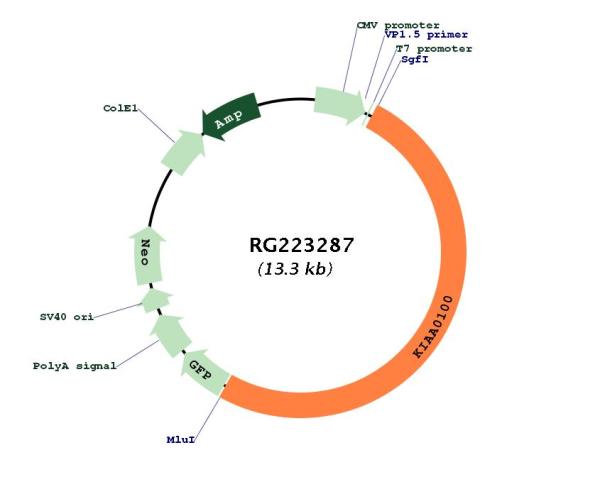KIAA0100 (NM_014680) Human Tagged ORF Clone
SKU
RG223287
KIAA0100 (tGFP-tagged) - Human KIAA0100 (KIAA0100)
-
TrueORF®
TrueORF®
Expression-ready ORF plasmid with C-terminal tag(s)
Click here to learn more.
| Product Data | |
| Type | Human Tagged ORF Clone |
|---|---|
| Target Symbol | KIAA0100 |
| Synonyms | BCOX; BCOX1; CT101; FMP27 |
| Vector | pCMV6-AC-GFP |
| E. coli Selection | Ampicillin (100 ug/mL) |
| Mammalian Cell Selection | Neomycin |
| Restriction Sites |
SgfI-MluI Cloning Scheme for this gene
Plasmid Map

|
| ACCN | NM_014680 |
| ORF Size | 6705 bp |
| OTI Disclaimer | The molecular sequence of this clone aligns with the gene accession number as a point of reference only. However, individual transcript sequences of the same gene can differ through naturally occurring variations (e.g. polymorphisms), each with its own valid existence. This clone is substantially in agreement with the reference, but a complete review of all prevailing variants is recommended prior to use. More info |
| OTI Annotation | This clone was engineered to express the complete ORF with an expression tag. Expression varies depending on the nature of the gene. |
| Components | The ORF clone is ion-exchange column purified and shipped in a 2D barcoded Matrix tube containing 10ug of transfection-ready, dried plasmid DNA (reconstitute with 100 ul of water). |
| Reconstitution Method | 1. Centrifuge at 5,000xg for 5min. 2. Carefully open the tube and add 100ul of sterile water to dissolve the DNA. 3. Close the tube and incubate for 10 minutes at room temperature. 4. Briefly vortex the tube and then do a quick spin (less than 5000xg) to concentrate the liquid at the bottom. 5. Store the suspended plasmid at -20°C. The DNA is stable for at least one year from date of shipping when stored at -20°C. |
| Note | Plasmids are not sterile. For experiments where strict sterility is required, filtration with 0.22um filter is required. |
| Shipping | Ambient |
| Reference Data | |
| RefSeq | NM_014680.5 |
| RefSeq Size | 7456 bp |
| RefSeq ORF | 6708 bp |
| Locus ID | 9703 |
| UniProt ID | Q14667 |
| Cytogenetics | 17q11.2 |
| Protein Families | Transmembrane |
| Summary | This gene was initially characterized in human as having high expression levels in breast carcinomas and breast cancer cell lines. This gene also has increased expression in prostrate cancer cells relative to normal prostrate tissues. Expression of this gene is negatively regulated by direct binding of the microRNA miR-195 to its 3' UTR. miR-195 has been shown to modulate the invasiveness of prostrate cancer cells and xenograft metastases by downgrading expression of this gene. In mouse, the protein encoded by this gene was identified as an antigen on acute monocytic leukemia cells. In human, alternative splicing results in multiple transcript variants encoding distinct isoforms; some of these isoforms are predicted to contain an RNA pol II promoter FMP27 protein domain and a Golgi-body-localization APT1 domain. [provided by RefSeq, Apr 2017] |
Write Your Own Review
| Product Manuals |
| FAQs |
| SDS |
Citations
*Delivery time may vary from web posted schedule. Occasional delays may occur due to unforeseen
complexities in the preparation of your product. International customers may expect an additional 1-2 weeks
in shipping.



